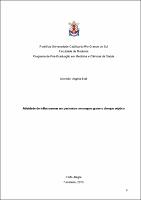| Share record |


|
Please use this identifier to cite or link to this item:
https://tede2.pucrs.br/tede2/handle/tede/1798Full metadata record
| DC Field | Value | Language |
|---|---|---|
| dc.creator | Eidt, Michelle Virgínia | - |
| dc.creator.Lattes | http://buscatextual.cnpq.br/buscatextual/visualizacv.do?id=K4186479A9 | por |
| dc.contributor.advisor1 | Oliveira, Jarbas Rodrigues de | - |
| dc.contributor.advisor1Lattes | http://buscatextual.cnpq.br/buscatextual/visualizacv.do?id=K4781448U1 | por |
| dc.date.accessioned | 2015-04-14T13:36:03Z | - |
| dc.date.available | 2015-04-10 | - |
| dc.date.issued | 2014-12-12 | - |
| dc.identifier.citation | EIDT, Michelle Virgínia. Atividade do inflamasoma em pacientes com sepse grave e choque séptico. 2014. 48 f. Dissertação (Mestrado em Medicina e Ciências da Saúde) - Pontifícia Universidade Católica do Rio Grande do Sul, Porto Alegre, 2014. | por |
| dc.identifier.uri | http://tede2.pucrs.br/tede2/handle/tede/1798 | - |
| dc.description.resumo | A sepse permanece sendo a principal causa de morte em UTI, podendo expressar índices de até 80% de mortalidade. Apesar de sua importância e a demanda de recursos, seu reconhecimento precoce ainda é um desafio, deixando margem para a ocorrência de disfunção de múltiplos órgãos e sistemas (DMOS), choque e desfechos fatais Estudos recentes vem apresentando teorias sobre o mecanismo fisiopatológico da sepse, na busca por novas alternativas terapêuticas. O principal responsável pela gravidade da sepse é a resposta inflamatória sistêmica, representada pela secreção de citocinas inflamatórias. Uma importante etapa do processo inflamatório é a atividade do inflamasoma, o qual funciona através da ativação da Caspase-1, permitindo a liberação de formas ativas das interleucinas IL- 1β e IL-18, sinalizando o início da resposta do sistema imune inato. Sendo assim o inflamasoma vem sendo amplamente estudado. Nosso estudo tem como objetivo avaliar se nas diferentes gravidades da sepse a atividade do inflamasoma (medida pelos níveis de IL-1 β e IL-18 no plasma) tem expressão diferente entre os grupos, e sua relação com a mortalidade. Os resultados demonstraram que a atividade do inflamasoma com o aumento dos níveis séricos de IL-18 pode ser o responsável pelo alto índice de mortalidade na sepse, independente do nível de IL-1β, apesar do processo de ativação e via de expresssão ser simultânea e a mesma. Portanto, nossas descobertas podem auxiliar na compreensão dos eventos inflamatórios que levam a sepse, podendo influenciar na investigação de terapêuticas futuras e na redução de mortalidade | por |
| dc.description.abstract | Sepsis remains the leading cause of death in the ICU and can express rates of up to 80% mortality. Despite the importance and demand for resources, the early recognition is still a challenge, allowing the occurrence of multiple organ dysfunction syndromes (MODS), shock and fatal outcomes. Recent research has shown theories about the pathophysiological mechanism of sepsis in the search for new therapies. The principal responsable for sepsis severity is inflammatory response, represented by the secretion of inflammatory cytokines. An important step in the inflammatory process is the activity of inflammasome, which functions through the activation of Caspase-1, allowing the release of active forms of interleukins IL-1β and IL-18, signaling the beginning of the response of the innate immune system. Therefore the inflammasome has been widely studied. Our study aims to assess whether the different severity of sepsis inflamossomo activity (measured by levels of IL-1 β and IL-18 in plasma) have different expression between groups, and their relationship with mortality. The results showed that the activity of inflamasoma with increased serum levels of IL-18 may be responsible for high mortality in sepsis, independent of the level of IL-1β, although the activation process and route of expresssão be simultaneous and same. Therefore, our findings may help to understand the inflammatory events that lead to sepsis, which may influence the future therapeutic and research in reducing mortality | eng |
| dc.description.provenance | Made available in DSpace on 2015-04-14T13:36:03Z (GMT). No. of bitstreams: 1 467262.pdf: 918245 bytes, checksum: f68b514ae6abf640bc976915b5b7f951 (MD5) Previous issue date: 2014-12-12 | eng |
| dc.format | application/pdf | por |
| dc.thumbnail.url | http://tede2.pucrs.br:80/tede2/retrieve/9354/467262.pdf.jpg | * |
| dc.language | por | por |
| dc.publisher | Pontifícia Universidade Católica do Rio Grande do Sul | por |
| dc.publisher.department | Faculdade de Medicina | por |
| dc.publisher.country | BR | por |
| dc.publisher.initials | PUCRS | por |
| dc.publisher.program | Programa de Pós-Graduação em Medicina e Ciências da Saúde | por |
| dc.rights | Acesso Aberto | por |
| dc.subject | MEDICINA | por |
| dc.subject | SEPSE | por |
| dc.subject | INFLAMAÇÃO | por |
| dc.subject | MORTALIDADE | por |
| dc.subject.cnpq | CNPQ::CIENCIAS DA SAUDE::MEDICINA | por |
| dc.title | Atividade do inflamasoma em pacientes com sepse grave e choque séptico | por |
| dc.type | Dissertação | por |
| Appears in Collections: | Programa de Pós-Graduação em Medicina e Ciências da Saúde | |
Files in This Item:
| File | Description | Size | Format | |
|---|---|---|---|---|
| 467262.pdf | Texto Completo | 896.72 kB | Adobe PDF |  Download/Open Preview |
Items in DSpace are protected by copyright, with all rights reserved, unless otherwise indicated.




